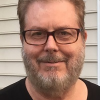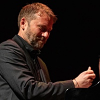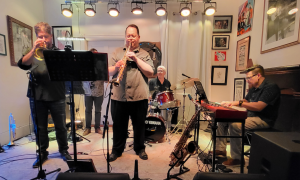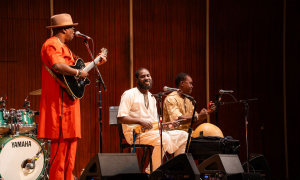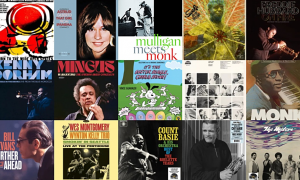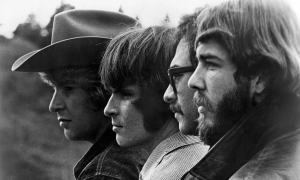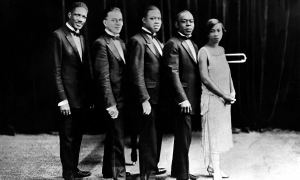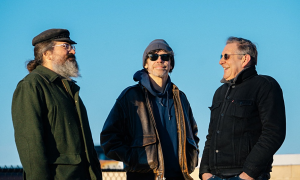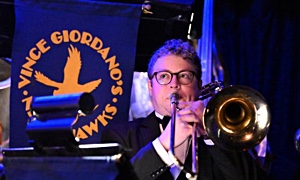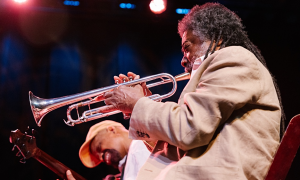Home » Jazz Articles » Live Review » Big Ears Festival 2025
Big Ears Festival 2025

Courtesy Andy Feliu
Knoxville, TN
March 27-30, 2025
This year's festival again featured several spotlighted events (but none of them required special ticketing, as was tried last year). "Across the Horizon" was a series of concerts combining Americana and ambient music, curated by Bob Holmes and the band SUSS. "Age of Reflections" hosted ambient music with a light show at Church Street United Methodist. "Blacktronika" celebrates the pioneering electronic artists of color. There were two residencies: drummer/composer Tyshawn Sorey and trumpeter/composer Wadada Leo Smith were featured in a diverse series of concerts (Smith's programs included an array of concerts featuring his pieces, under the CREATE banner). Among the many special performances, composer Philip Glass's landmark minimalist composition, Music in Twelve Parts, was presented over two days. Collaborating with Blue Note Records created a new venue—the Blue Note Lounge—which hosted panel discussions, signings and other special events.
Thursday, March 27
Tigran Hamasyan
Armenian composer/pianist/keyboardist Tigran Hamasyan presented a concert version of the music from his album The Bird of a Thousand Voices. Based on a traditional Armenian tale of the same name, the entire project is a multimedia production, including a live play, two music videos, a documentary music video and an online game. The concert version features Hamayasan's musical compositions only. The recording included several vocalists, a violinist, bassist and drummer in addition to Hamasyan's piano, synthesizer and vocals. At Big Ears he led a quartet with second keyboardist Yessaï Karapetian, bassist Marc Karapetian and drummer Matthew Garstka. The opening tune found his keyboardist playing flute (doubling the piano melody), immediately demonstrating that this band has mastered dynamics. After the second song Hamasyan introduced his bandmates and described the multimedia project from which this music came. "Prophecy Of A Sacrifice" included vocals from the leader and both Karapetians and whistling. "The Saviour Is Comdemned" was played by the trio until the end, after Hamasyan set up a synthesizer sequence. His keyboardist joined to take the first solo, showing that his chops may rival the leader. "Only The One Who Brought The Bird Can Make It Sing" had Karapatian playing piano, with Hamasyan on synthesizer and vocals. The next tune began with piano and whistling. He challenged the audience to a sing-along, and the initial response prompted him to joke, "You can tell it's a jazz festival." The singing finally got strong enough that he threw in some tricky re-harmonizations. The band played "Red, White And Black Worlds" as an encore (which featured the bass playing the bridge melody), followed by "The Well Of Death And Resurrection."Charles Lloyd: Homage to Zakir Hussain
The festival schedule originally included a performance by Sangam, a trio led by saxophonist Charles Lloyd, Zakir Hussain (table, voice, and percussion), and Eric Harland (drums, percussion, and piano). The live album of the same name was recorded in 2004 and released by ECM Records in 2006. Hussain's unexpected death in December 2024 led to the creation of this concert in homage to him. Lloyd asked Sangam band mate Harland, guitarist Bill Frisell, double bassist Harish Raghavan, and Indian vocalist Ganavya (who sang some of Hussain's original pieces) to join him. The atmosphere was mournful and reflective. The first piece had a rubato rhythmic feel, which was frequent in the music. After starting on tenor saxophone, Lloyd moved to the piano, then shakers, leaving ganavya's mournful vocals to dominate, as she did through much of the set. Harland moved to piano for the second piece, and Lloyd switched to flute. For the next selection, a drum solo opened, followed by an Indian-sounding melody on sax: a recognizable tune, with no vocals. The folk tune sound continued through the rest of the set. For the encore, Lloyd played tárogató for the first time, followed by abstract sound from guitar and bass. Moving to piano, Lloyd concluded the set with a recitation about attachment to sense objects and the free mind.Axiom 5 (Barry Altschul)
Drummer Barry Altschul began this concert saying that it would be 100% improvised music, "I hope you enjoy it." He introduced the band members (without a microphone, so I hope this is correct): pianist Uri Caine, double bassist Mark Helias and saxophonist Jon Irabagon. The first improvisation began with a rubato rhythmic feel, but busy, and it slipped into swing briefly. It included an arco double bass solo accompanied by playing inside the piano, lyrical tenor saxophone, and a surprisingly mainstream piano solo. All of this should be unsurprising given the reputations of these players. The second improvisation started like fast bebop before featuring a Cecil Taylor—like abstract piano solo; later Caine played another solo that sounded like a wilder Keith Jarrett. Irabagon played a wild sopranino saxophone solo, which eventually led to a Swing-era ballad feel. The third selection had Caine playing stride piano, demonstrating his command of the entire history of jazz piano. The fourth and final segment included a lot of pizzicato double bass, and yet another lyrical tenor saxophone solo. The whole band, especially Irabagon, created very impressive improvisations. A listener could easily believe they were composed rather than created in real time.Friday, March 28
Immanuel Wilkins' Blues Blood
Alto saxophonist Immanuel Wilkins brought most of the core band from his album Blues Blood (Blue Note, 2024): pianist Micah Thomas, bassist Ryoma Takenaga, drummer Kweku Sumbry, and vocalists Ganavya, June McDoom, and Yaw Agyeman. Chef Pierre Serrao was at center stage cooking. No explanation was given, but it did smell good. The set began with a rubato groove, Gospel-style vocals, and organ: like a church service. The second piece was more upbeat, and Wilkins cut loose with a big solo, followed by a fine piano solo. Baritone Agyeman had a prominent feature, concluding with all three vocalists singing "branch to trees, roots to leaves." Ganavya reprised her feature "Everything" from the album. The main emphasis was the group sound and the vocals, but the leader contributed another dramatic extended solo. Wilkins has found a way to explore his roots while also making music that sounds contemporary.Brandon Seabrook
Guitarist Brandon Seabrook presented a stripped-down version of music from his album Object of Unknown Function (Pyroclastic Records, 2024). The recording frequently employed overdubbing, and Seabrook played guitar banjo, tenor banjo, Fender Telecaster electric guitar and a Jerry Jones Neptune twelve-string electric guitar. This performance used only the twelve-string, plus some effects pedals. The opening pieces included a driving chord progression with some brief pitch-shifting; guitar body slapping, plus some big fuzz and heavy reverb. Searook dedicated a piece to former teacher Ra-Kalam Bob Moses (who would probably not like it at all): a high string piece with capo, including fast ostinatos. "Perverted by Perseverance" was very physical: Seabrook plays standing up, and moves a lot. He recalled an earlier Big Ears performance with Anthony Braxton, where Braxton asked him "Brandon, what's your last name?'' before making the band introductions. He dedicated his next performance to Braxton, with its call-and-response figures. "Some Recanted Evening" was defined by its very long reverb, which Seabrook held to end his performance. An extreme pause, which the audience honored.Tyshawn Sorey's Monochromatic Light (Afterlife)
Drummer/pianist/composer Tyshawn Sorey's composition was inspired by Morton Feldman's music to commemorate the opening of the Rothko Chapel in Houston. MacArthur "Genius,' and now Pulitzer prize-winning Tyshawn Sorey has created a new piece, commissioned by DA CAMERA and the Park Avenue Armory, as a tribute to both the profoundly contemplative space and the work by this composer that has influenced his creative output. Sorey conducted the St. John's Episcopal Choir, bass-baritone Davone Tines, violist Kim Kashkashian, percussionist Steven Schick, and keyboardist Sarah Rothenberg (piano/celesta) in this large—scale work. The deliberate pacing of the music was immediately evident in Schick's soft tubular bell opening: several minutes of barely audible chime swells. When the rest of the chamber ensemble entered (including piano, celesta, vibes, timpani and gongs) Kashkashian's viola sang a rhapsodic melody. Hers was the prominent voice throughout much of the piece. The choir contributed a wordless vocal texture, almost like a synthesizer pad. Bass-baritone Tines's first entry was more dramatic and songlike, albeit still wordless. Rothenberg played two extended unaccompanied piano solos, giving the piece another contrasting texture. It was a measured and episodic composition, but it did reach a climax, including dramatic timpani and tubular bells accents. Ultimately, the choir had the last word after bass and viola solos—a beautiful, calm oasis amid a sometimes frenetic festival.Steve Coleman & Five Elements
Steve Coleman & Five Elements has always been alto saxophonist/composer Steve Coleman's primary ensemble for presenting his music. Greeting the audience, he said that the band was previously booked for the festival, but the pandemic put a stop to that. He introduced his bandmates: trumpeter Jonathan Finlayson, bassist Anthony Tidd, and drummer Sean Rickman. All of these players have a long history with Coleman's music, especially Finlayson. Coleman began the set with an unaccompanied alto sax solo, joined by the trumpet, then the whole band played the head. As usual, the tunes frequently employed ostinatos, often using funk rhythms in unusual time signatures. Coleman's music features a unique combination of bebop, funk and hip-hop. A version of Thelonious Monk's standard "Round Midnight" hid the original behind a radically different rhythm. Coleman demonstrated it, after a tune including an audience sing-along. The final tune (almost) featured a slow build to the head (including percussion playing by Coleman and Finlayson). Coleman sang the head with the trumpet to end. He joked about playing another five minutes ("I need two hit songs"). The band played an encore, starting with a bass groove, and Coleman finished with playing and singing the Frank Sinatra standard "My Way."Saturday, March 29
Philip Glass Ensemble: Music in Twelve Parts (Pts 7-12)
Composer Philip Glass's Music in Twelve Parts stands as a landmark in his early work, as well as for minimal music generally. This version of the Ensemble does not include Glass, but features experienced performers of the music, led by keyboardist Michael Riesman. The personnel was: Michael Riesman, music director, keyboard; Lisa Bielawa, voice, keyboard; Dan Bora, sound; Peter Hess, alto and tenor saxophone; Ryan Kelly, onstage sound; Mick Rossi, keyboard; Sam Sadigursky, soprano saxophone, flute; and Andrew Sterman, flute, piccolo, soprano saxophone. The first thing to note about the performance is the volume: it is loud—rock band loud. It is unlikely that most listeners listen to the recordings with anything like this intensity, but if they want to experience the music as intended they probably should. The ensemble included two organs (not period Farfisa combo organs, but they had the same sound), three woodwinds and a female vocalist. Parts 7-9 were all fast. Part 7 included a surprising bit of harmony; Part 8 had arpeggiated keyboard parts with a long-toned vocal on top; and Part 9 omitted the vocals. This listener was delighted to experience the music live for the first time, but another concert beckoned.Wadada Leo Smith: Revolutionary Fire-Love
Gardens of Peace was a continuous five-part piece performed by an ensemble including trumpeter/composer Wadada Leo Smith, Yosvany Terry (saxophone, chekrere), Ashley Walters (cello), Seiyoung Jang (electronics), Vijay Iyer (piano, Fender Rhodes), Erika Dohi (piano), Yvette Janine Jackson (electronics), and Andrew Cyrille (drums). It opened with two grand pianos, joined by trumpet and drums. The cued theme was played by trumpet, sax and cello, leading to saxophone and cello solos. Dohi had a dramatic, rambling classical piano solo; and the piece ended with a cued drum solo and unaccompanied trumpet. The performance concluded after about half an hour, so Smith ruminated about the quality of being. How much do we feel about others, and is there unconditional caring? We talk about love, but we don't know what it is. Love is beyond creation. Like many of Smith's projects, the sound was defined primarily by the choice of players, with his trumpet serving as the unifying element.Joel Harrison: Free Country
Free Country explores country music, broadly defined to encompass traditional Country and Western, Americana and bluegrass. Jazz guitarist Joel Harrison has pursued this concept since 2000, and there have been three Free Country albums. The lineup was Harrison on guitar and vocals; saxophonist Greg Tardy, keyboardist Gary Versace, violinist Darol Anger (a founding member of The David Grisman Quintet), vocalist Evelyn Jack, electric bassist Stephan Crump, and drummer Rudy Royston. The set began with Bill Monroe's "Jerusalem Ridge," a complex bluegrass tune that gave the band plenty of opportunities to shine. The fiddle tune "Lost Indian" included not only lots of fiddle, but a drum solo with bass accompaniment. Vocalist Jack came onstage to sing "Twelve Gates to the City," a classic gospel song by the Reverend Gary Davis, raising the energy level considerably. Harrison wondered whether most people would consider the next tune to be country. Still, either way, Bob Dylan's classic protest anthem "The Times They Are a-Changin'" sounded great and inspired the leader to play a strong guitar solo. Johnny Cash's "Ring of Fire" was given a funk rhythmic treatment; Harrison ended the song with a humorous recitation of the lyrics through a megaphone. He mused about the African roots in country music, proclaiming that all American music comes from the same well. "Midnight Train" featured Harrison's vocals, while "Wichita Lineman" was a guitar feature. "Tennessee Waltz" was not on the set list originally, but "we are in Tennessee... " It inspired some audience dancing, surely the best response one could ask for. The show closed with the chestnut "Shady Grove," featuring another Harrison vocal. This was a terrific band, playing creative arrangements of a wide variety of American music: Big Ears in a nutshell.Steve Roach
Composer/synthesist Steve Roach has had a long career in ambient and electronic music, influencing the trance and New Age genres. Age of Reflections' light show accompanied his three concerts at the Church Street United Methodist Church. The set began with a low string drone plus sub bass, with a reverberant piano-like sound on top. The lights were white, moving across the back wall of the sanctuary. Throughout the two-hour performance Roach introduced a new musical element every ten minutes or so, usually accompanied by changes in the lights. The addition of a sequencer prompted light changes, and another sequencer change led to organic looking colored lights. Musical changes like washes and filter resonance sweeps triggered dramatic orange and red spiralling lights. Roach employed a physical controller like a staff to control things like filter resonance, followed by an Australian didgeridoo, taking him out of the synthesizer realm. He then used shaker, ocarina, finger cymbals and rattles. He came down to the front of the sanctuary to a single synthesizer for the conclusion. Playing a simple three-chord vamp, he paused for the sound of church bells—then resumed, lowering the volume of the vamp until it had faded out. Age of Reflection produced effects that seemed to alter the physical architecture of the space: Roach's music changed the audience's consciousness.Jenny Scheinman's All Species Parade
Violinist Jenny Scheinman presented music from her album All Species Parade (Royal Potato Family, 2024), featuring guitarists Bill Frisell, Julian Lage, and Nels Cline, pianist Carmen Staaf, bassist Tony Scherr, and drummer Kenny Wollesen. "Ornette Goes Home" gave everyone in the core band a solo: Scheinman, Frisell, Staaf, Scherr and Wollesen. "House of Flowers" was inspired by a fragrance. It was a melodic folk-rock tune, featuring Cline playing a "swirl" part and a dancer interpreting the music. "Every Bear That Ever There Was" was a charming march, with a great piano solo. "Shutdown Stomp" brought Lage onstage playing acoustic guitar, along with another great piano solo, as well as one from Frisell. The "All Species Suite" featured Lage on electric guitar with Cline. "Nocturne for 2020" was an elegy and prayer for disappearing species, with Lage on acoustic guitar solo. "The Cape" was a surf rock tune (surfing is the only sport with a musical genre). "Song for Sidiki" is an African dance song from an earlier version of the band. Lage played an electric guitar solo, followed by Cline (with especially great energy), a piano solo, and a double bass solo playing with the rhythm.Sunday, March 30
Susan Alcorn Tribute
Adventurous pedal steel guitarist Susan Alcorn had been booked for the festival, but passed away in January. Her band members—violinist Yuniya Edi Kwon, vocalist Bonnie Lander, guitarist Mary Halvorson, bassist Lester St. Louis and drummer Ryan Sawyer—chose to perform some of her music in tribute. Sawyer began by talking about the difficulty of reworking Alcorn's arrangements without her unique voice in the mix—playing her music without her. He read her program notes for "Pedernal" from the album of the same name (Relative Pitch Records, 2020). Alcorn began the tune on the recording, but the band took a similar textural, very soft approach until Lander sang the pastoral theme. Halvorson took a guitar solo replete with her trademark Whammy pedal pitch bends, followed by a violin solo before returning to the head. The second tune began with a drum solo, including some very pedal steel-like Whammy pedal glissandi and an extended violin solo. "A Night in Gdansk" has a memorable start-stop theme, and featured a free guitar/vocal duet. "Nitrogen Could Dance" was a song inspired by a fever dream, and included appropriately wild vocalese (growling and other noisy voice sounds). The final piece incorporated an audience clap-along. The head was a catchy tune with a slightly Celtic flavor, a fine conclusion to an inspiring concert.Wadada Leo Smith's Radio Light & Orange Wave Electric
Trumpeter/composer Wadada Leo Smith's final show presented two very different ensembles. Radio Light played No. 1 Fall (Ankhrasmation Music) . It was an acoustic group, including Chinese musician Min Xiao-Fen (pipa and vocals), bass clarinetist Martin Walker and drummers Andrew Cyrille and Ra-Kalam Bob Moses. Xiao-Fen's role was second only to Smith's: her pipa (a lute-like instrument) and wild vocals were often featured, along with drum solos. The entire set was only about 20 minutes long. Orange Wave Electric presented quite a contrast, performing Fire Illumination and Obama On The Bridge. It was a loud electric group, including guitarists Brandon Ross and Lamar Smith, electronic sound designer Hardedge, electric bassist Melvin Gibbs and drummer Greg Saunier (of the band Deerhoof). Great high-energy guitar playing on the opener, and Saunier was way into it. So much so that Smith had to get in his face to get him to tone it down! Gibbs played a huge riff to launch the next piece, but it was time to get to the next concert.Nels Cline Consentrik Quartet
Guitarist/composer Nels Cline is involved in a wide variety of projects, with his playing in the band Wilco probably the most visible. This band plays the most explicitly jazz music of any of them; in fact Cline initially held off on using effects pedals, before giving in to his natural impulses. The band was the same as on the album (Blue Note Records, 2025): Nels Cline: electric guitar, effects; Ingrid Laubrock: tenor & soprano saxophones; Chris Lightcap: acoustic bass, effects; and Tom Rainey: drums. The opener started rubato with a tenor saxophone/guitar conversation (a frequent event in the set). Cline created a runaway loop at the end of his solo. "Question Marks (The Spot)" led into the Monk-like "Surplus," which featured a tenor sax solo and a guitar solo with octaves and rhythm playing leading to twangy guitar. "Satomi" had a singable head, played on soprano sax, and Lightcap created a double bass loop for the ending. "The Bag" was dedicated to Tom Rainey, and he played an unaccompanied solo to start it. After a start-stop head there was a tenor sax/drum duet, an ostinato played by the whole band, and a processed guitar solo with loop manipulation. "Allende" (which referred to Salvador, not Isabel) and "House of Steam" were played together. The performance started with a Spanish double bass melody, accompanied by strummed guitar. The second head was played over an ostinato; processed guitar was shadowed by tenor sax, and the tune ended with a unison riff. Cline said that the band had not played together for a while and were bashing through the material. Excellent bashing, if so.A terrific festival, as always. So much great music! For the record, my regrets included missing trumpeter Ambrose Akiminsure; Joel Harrison's Alternate Guitar Summit; Darkside; Nels Cline Singers; Suss Across the Horizon; 101 Audio Odyssey; Free Form Funky Freqs; Tortoise; Fieldwork; Adam Rudolph (multiple shows); Squanderers; Wendy Eisenberg; Michael Rother; SML; and Anoushka Shankar.
Tags
Live Review
Wadada Leo Smith
Mark Sullivan
Pitch Perfect PR
United States
Tennessee
Knoxville
Big Ears Festival
Tyshawn Sorey
Philip Glass
Tigran Hamasyan
Yessaï Karapetian
Marc Karapetian
Matthew Garstka
charles lloyd
Bill Frisell,
Harish Raghavan
Ganavya
Barry Altschul
Uri Caine
Mark Helias
Jon Irabagon
Cecil Taylor
Immanuel Wilkins
Micah Thomas
Ryoma Takenaga
Kweku Sumbry
June McDoom
Yaw Agyeman
Brandon Seabrook
Ra-Kalam Bob Moses
Davone Tines
Kim Kashkashian
Steven Schick
Sarah Rothenberg
Steve Coleman
Jonathan Finlayson
Anthony Tidd
Sean Rickman
Thelonious Monk
Michael Riesman
Lisa Bielawa
Peter Hess
Mick Rossi
Sam Sadigursky
Andrew Sterman
Yosvany Terry
Ashley Walters
Seiyoung Jang
Vijay Iyer
Erika Dohi
Yvette Janine Jackson
Andrew Cyrille
Joel Harrison
Greg Tardy
Gary Versace
Darol Anger
David Grisman
Evelyn Jack
Stephan Crump
Rudy Royston
Steve Roach
Jenny Scheinman
Bill Frisell
Julian Lage
Nels Cline
Carmen Staaf
Tony Scherr
Kenny Wollesen
Susan Alcorn
Bonnie Lander
Mary Halvorson
Lester St. Louis
Ryan Sawyer
Min Xiao-Fen
Martin Walker
Brandon Ross
Lamar Smith
Hardedge
Melvin Gibbs
Greg Saunier
Wilco
Ingrid Laubrock
Chris Lightcap
Tom Rainey
Zakir Hussain
Yuniya Edi Kwon
Big Ears Festival 2025
Comments
PREVIOUS / NEXT
Support All About Jazz
 All About Jazz has been a pillar of jazz since 1995, championing it as an art form and, more importantly, supporting the musicians who make it. Our enduring commitment has made "AAJ" one of the most culturally important websites of its kind, read by hundreds of thousands of fans, musicians and industry figures every month.
All About Jazz has been a pillar of jazz since 1995, championing it as an art form and, more importantly, supporting the musicians who make it. Our enduring commitment has made "AAJ" one of the most culturally important websites of its kind, read by hundreds of thousands of fans, musicians and industry figures every month.

